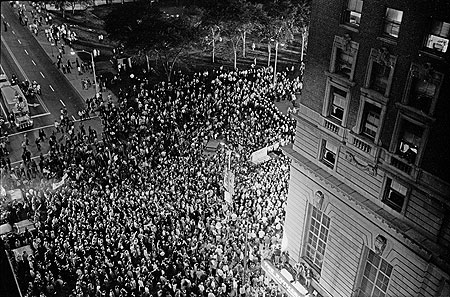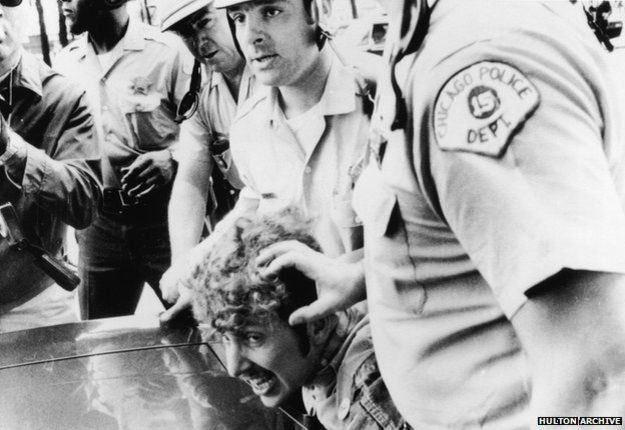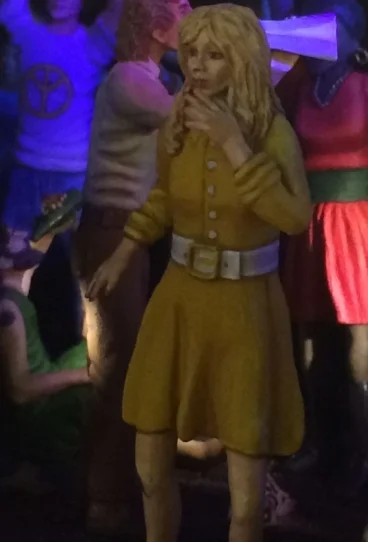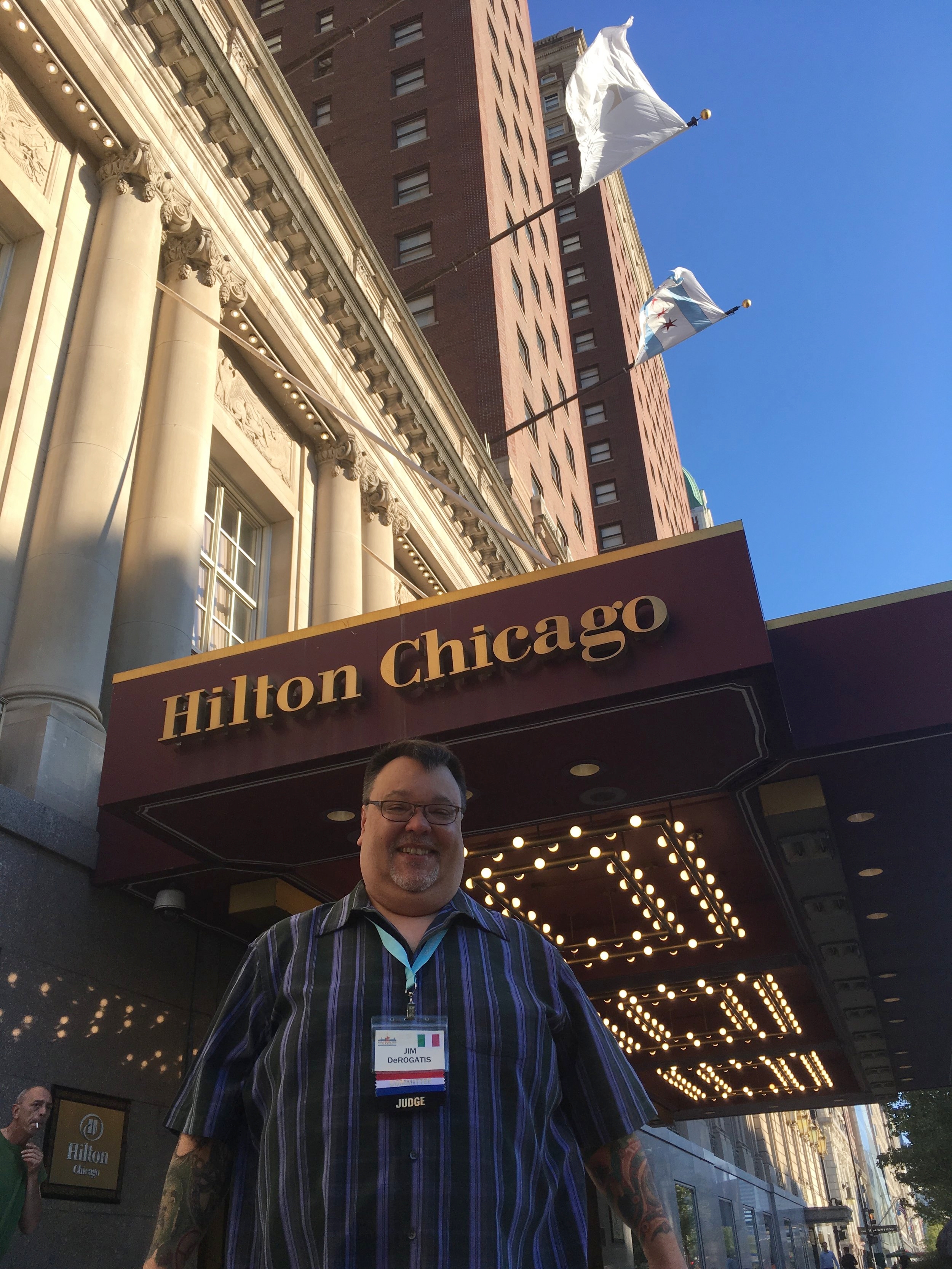THE WHOLE WORLD IS WATCHING
CHICAGO 1968
My Latest Box Diorama, by Jim DeRogatis
In August 1968, mired in controversies surrounding the war in Vietnam, Lyndon B. Johnson decided not to run for re-election. Chicago’s infamous Boss, Mayor Richard J. Daley, lobbied to hold the convention to nominate another Democrat for president in Our Town. The formal gathering took place at the International Amphitheatre (now torn down, it was located near where the United Center now stands), but most of the fiercely divided delegates as well as the competing candidates—Vice President Hubert H. Humphrey, Sen. Edmund Muskie, Sen. George McGovern, and Sen. Eugene McCarthy—stayed six miles away, at the Hilton Hotel on Michigan Avenue.
Not long after the steering committee for Chicago World Expo 2017 settled on the Hilton as the site for last summer’s big show, I knew the box diorama I wanted to make. I started work in December 2015, beginning with the 1/24th scale vehicles (a vintage kit of a Plymouth Fury police cruiser by Jo-Hann that I super-detailed and a Revell pickup that provided the chassis for a scratch-built paddy wagon), and I finished 52 figures later a month before Expo in July 2017, with a few breaks along the way—my most ambitious project yet!
A little more history before we get to the step-by-step. Chicago already had been the site of serious civil unrest on the South and West sides following the assassination of the Rev. Martin Luther King, Jr. in April 1968. Daley believed the police should have responded to those riots with more force—he was disappointed that many officers had not followed his order to “shoot to kill arsonists” and “shoot to maim looters”—and he vowed that the planned anti-war protests coming to Chicago for the convention would be dealt with more harshly.
These protests were loosely organized by the free-wheeling New York Yippies and the much more sober-minded National Mobilization Committee to End the War in Vietnam (the MOBE), competing groups that never had a focused agenda, and which could not have been more different stylistically. Daley’s courts made matters worse by delaying the granting of permits for protestors to gather and sleep in either Grant Park, directly across from the Hilton, or Lincoln Park, a little less than five miles to the North along Lake Michigan. The permits never came through, and each night, police cleared the parks, often with teargas and swinging billy clubs—tactics that backfired when protestors swarmed into the streets of Lincoln Park, Old Town, and the South Loop, smashing store and car windows until they were chased down, beaten, and thrown into paddy wagons.
All of this was captured by journalists, who often were bigger targets than the protestors (including future anchorman Dan Rather, who was beaten by Daley’s thugs while broadcasting from the floor of the convention as Walter Cronkite expressed disgust at the violence). The most infamous pictures came from the clashes directly in front of the Hilton, on Michigan Avenue between Balbo Drive and Harrison Street. As the delegates and candidates watched from the upper-floor windows of the hotel, choking on drifting tear gas, police beat protestors and journalists, even throwing some through the plate-glass windows of what is now Kitty O’Shea’s Pub. Amazingly, to borrow the title from one of the best books on these events, no one was killed, though local and federal commissions studying the events in their aftermath termed the incident “a police riot”—that is, a riot that actually was started by the police—which prompted the thick-tongued Mayor Daley to utter his famous quote, “The police are not here to create disorder, they’re here to preserve disorder.”
In time, the National Guard was called in, and in contrast to later events on the campus of Kent State in Ohio, the soldiers managed to calm down both the police and the protestors, and the riots ended with the convention (which nominated Humphrey, who went down to a stunning defeat at the hands of Republican Richard M. Nixon). Historians now consider the events at the 1968 Democratic National Convention to be the turning point for many Americans’ opposition to the War in Vietnam, but the story did not end there: Nearly as infamous was the trial of the so-called “Chicago Eight” that followed. Prosecutors attempted to place the blame for the riots on “outside agitators” Abbie Hoffman, Tom Hayden, David Dellinger, Rennie Davis, John Froines, Jerry Rubin, Lee Weiner, and Bobby Seale (a Black Panther who barely took part in the protests and whose case eventually was severed from that of the other seven, but not before he notoriously was bound and gagged in Judge Julius Hoffman’s courtroom). Defended by a team lead by free-speech activists William Kunstler and Leonard Weinglass, the Eight were all convicted, and the judge threw their attorneys in jail, too, for allegedly trying to turn the trial into a media spectacle (which it was). The convictions all were eventually reversed on appeal, and the government declined to try the case again.
As a student of rock music, the counterculture, and the Sixties, who teaches at Columbia College Chicago at the epicenter of these events, the 1968 Riots hold a special fascination for me, and I strongly recommend as the best books on the subject the following: No One Was Killed: The Democratic National Convention, August 1968 by John Schultz (later a legendary professor fiction writing at Columbia); Battleground Chicago: The Police and the 1968 Democratic National Convention by Frank Kusch (who tells the story from the cops’ perspective); Chicago ’68 by David Farber, and Miami and the Siege of Chicago by the great Norman Mailer. Also recommended: Conspiracy in the Streets: The Extraordinary Trial of the Chicago Eight by Jon Wiener; The Chicago Conspiracy Trial by John Schultz, and Days of Rage: America’s Radical Underground, the FBI, and the Forgotten Age of Revolutionary Violence by Bryan Burrough. Now, on to the diorama!
As always, work began with some rough positioning. I started with the vehicles because I wanted them to frame the back of the scene, and provide much of the light. (I wired LEDs into them during assembly.)
Yes, I know these figures evoke the famous photo from Kent State, but my goal was less historical accuracy than capturing the mood of the turbulent ’60s. Everything in the box builds from this vignette at the center.
The first rough cardboard mock-up. The vantage point has the viewer with his or her back to the front door of the Hilton on Michigan Avenue, standing under the lighted canopy pictured at the top of the next column. It took a lot of experimenting to get here, but the device nicely frames and constrains the outdoor scene and provides another opportunity for dramatic lighting.
Joe Berton made the invaluable suggestion of adding a third figure to the central vignette, making it a little less “Kent State” and a lot more interesting. The wire mannequin built on my resin-cast pelvis and torso is how every 75mm figure in the box began. (Some of the forced perspective figures were sculpted over Airfix or Historex.)
The scene expands on a temporary Styrofoam base.
More figures in progress: Hippies to the right of us…
Police to the left! Coming together with a whole lot of Green Stuff, Apoxie Sculpt, lead foil, and scratched, then resin-cast police gear!
“Characters” in this play, from left: Marc Gaynes (he was there, but he had hair back then); Abbie Hoffman; Jerry Rubin; a Father Berrigan-type, and Shep Paine (who wasn’t there, but he could have been, during his time at the University of Chicago). The hippie girl isn’t based on anyone in particular, but I was proud of this figure, and I did a whole lot of research into period-appropriate fashions. I should add here that painting changed a lot for many of these figures as I continually tweaked the colors, shadows, and highlights based on how they actually appeared in the lighting of the box -- essential for anyone building a box diorama, because what looks good on the work bench might not be right in the actual scene with the final lighting!
From left: Tom Hayden, a “Black Power” couple, and Allen Ginsberg; the archetypal Chicago Police Sergeant; “the girl in the yellow dress’ from Haskell Wexler’s Medium Cool, which the director shot onsite as the riot unfolded, and an officer arresting a protestor.
It takes a whole lot of cops to make a riot, and hippies, too! Note the forced perspective trees and figures in the background on the right. Those are “cheater” spots atop the entryway. The putty on Rubin holds a fiber optic in place for his joint.
A look at the electronics, and more police officers. The Yippies ran a pig called “Pigasus” for President. CPD arrested it.
Above: Two photos of the box by my pal and ace photographer Bob Sarnowski. Below: The box on display at World Expo Chicago, and a photo Joe Berton took of me during the big show near the entryway depicted in the diorama.






























